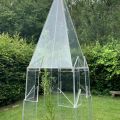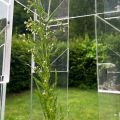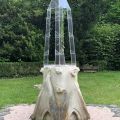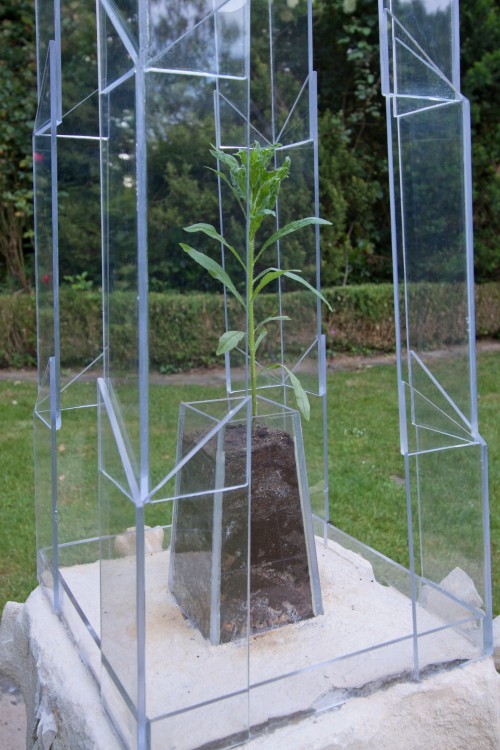SCULPTURE / INSTALLATION
Plant: Conzya Canadensis (Canadian horseweed)
The Neophyte Shrine is located in Münster in the district of Kinderhaus, in a large garden that belongs to the house of a parish priest. A portion of the garden is separated and enclosed by hornbeam hedges. Entering through a small opening in the hedgerow, the shrine is located in the middle of the lawn.
The shrine encompasses an old base that originally was part of a gothic building made from sandstone, a so-called ‘pinnacle’. It probably once belonged to a church and it is a reasonable possibility that this is a chunk of debris from the ruins of a destroyed Münster during the Second World War. The missing spire of the pinnacle is completed again by a (plexi)glas construction referring to form, size and architectural style of the original. The attachment functions and doubles as a greenhouse for a single plant with a pillared growing shape. This fits beautifully to the gothic pinnacle – the Canadian horseweed (Conzya Canadensis).
This species belongs to the so-called ‘neophytes’, these are plants that arrived in new territories after 1492. This year is the discovery of America by Christopher Columbus. For botanists it marks the beginning of global human activities, enabling plants to spread and reach new territories where they cannot be found naturally.
The Canadian horseweed was probably brought to Europe in the 17th century and has become one of the most common plants in urban areas. Often considered as a disturbing weed plant, cities and municipals fight the growth of this plant with effort and money. Even a lot of plant lovers do not appreciate the plant because it is not indigenous. In Germany the plant became extremely noticeable in the rubble fields of the Second World War. It was one of the most common species growing in the destroyed city of Stuttgart. It was also one of the few plants that had no, or little problems with the contaminated rubble, among others – the phosphor of the incendiary bombs. The Canadian horseweed is nowadays also known as one of the few ‘superweeds’, in varieties appearing in American soya cultivation that have become immune against ‘total herbicides’ based on glyphosate.
Neophyte Shrine is a temporary installation in the public space. It is shown in scope of KUNST AM RAND in ‘Kinderhaus’, a district of the city Münster in Germany between June and September 2020. More information: https://www.stadt-muenster.de/kunst-am-rand/startseite.html
Plant blooming in july 2020:



photography Helmut Dick, Marcus Lütkemeyer
special thanks to Martin Grünert for looking after the plant and watering it !




